2000 HONDA S2000 height
[x] Cancel search: heightPage 29 of 273
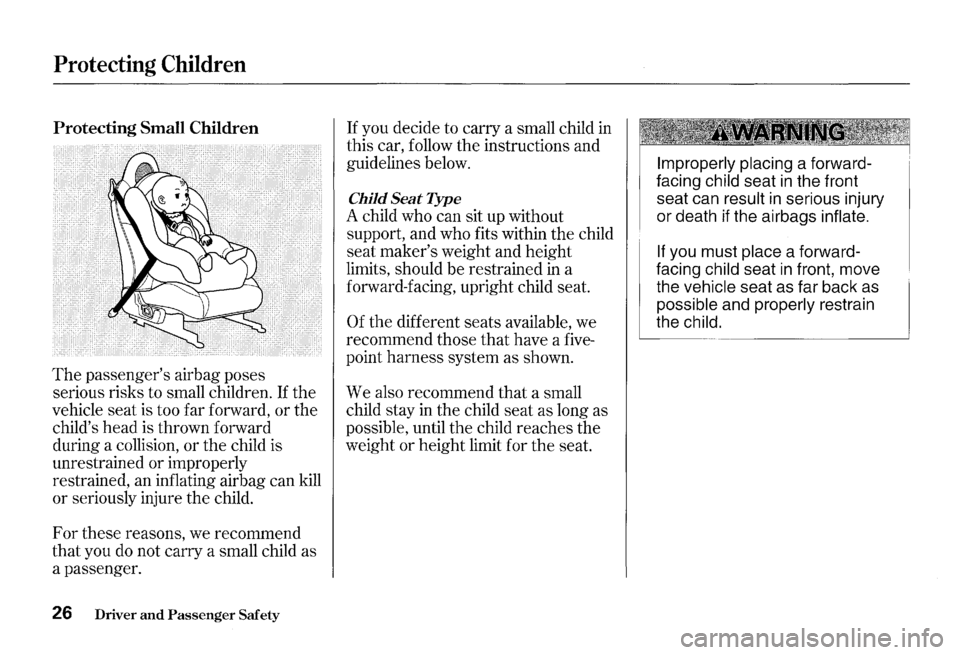
Protecting Children
Protecting Small Children
The passenger's airbag poses
serious risks to small children.
If the
vehicle seat is too far forward, or the
child's head is thrown forward
during a collision, or
the child is
unrestrained or improperly
restrained, an inflating airbag can kill
or seriously injure the child.
For these reasons, we recommend
that you
do not carry a small child as
a passenger.
26 Driver and Passenger Safety
If you decide to carry a small child in
this car, follow the instructions and
guidelines below.
Child Seat Type
A child who can sit up without
support, and who fits within the child
seat maker's weight and height
limits, should be restrained
in a
forward-facing, upright child seat.
Of the different seats available, we
recommend those
that have a five
point harness system as shown.
We also recommend that a small
child stay
in the child seat as long as
possible, until the child reaches the
weight or height limit for the seat.
Improperly placing a forward
facing
child seat in the front
seat can
result in serious injury
or death if the airbags
inflate.
If you must place a forward
facing
child seat in front, move
the
vehicle seat as far back as
possible and properly restrain
the
child.
Page 32 of 273
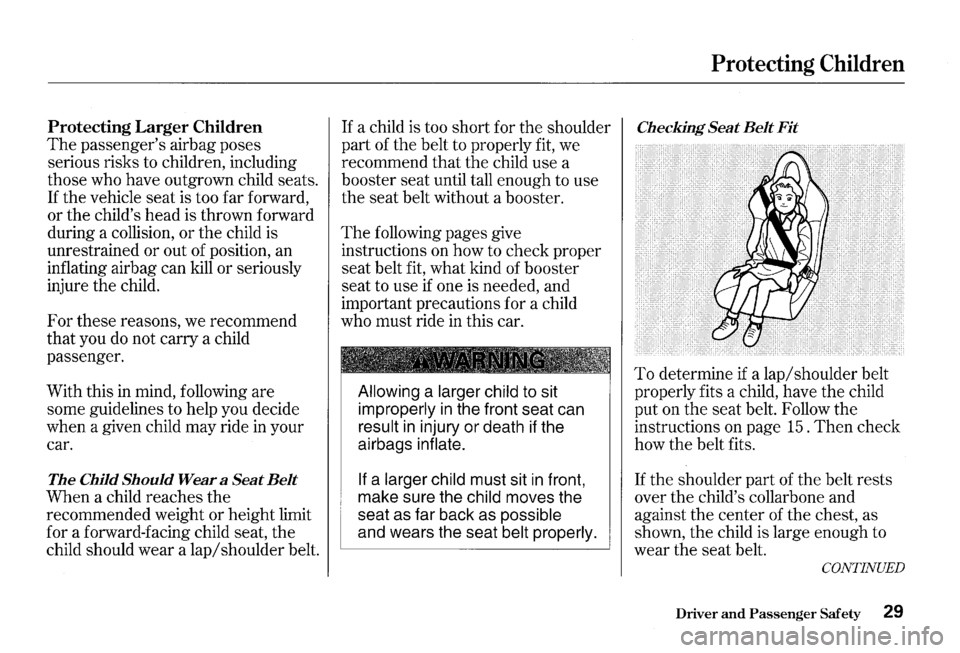
Protecting Larger Children
The passenger's airbag poses
serious risks to children, including
those who have outgrown child seats.
If the vehicle seat is too far forward,
or the child's head is thrown forward
during a collision, or the child is
unrestrained or out of position, an
inflating airbag can kill or seriously
injure the child.
For these reasons, we recommend
that you
do not carry a child
passenger.
With this
in mind, following are
some guidelines to help you decide
when a given child may ride in your
car.
The Child Should Wear a Seat Belt
When a child reaches the
recommended weight or height limit
for a forward-facing child seat, the
child should wear a lap/shoulder belt.
If a child is too short for the shoulder
part of the belt to properly fit, we
recommend that the child use a
booster seat until tall enough to use
the seat belt without a booster.
The following pages give
instructions on how to check proper
seat belt fit, what kind of booster
seat to use
if one is needed, and
important precautions for a child
who must ride in this car.
Allowing a larger child to sit
improperly in the front seat can
result in injury or death if the
airbags
inflate.
If
a larger child must sit in front,
make sure the
child moves the
seat as far back as
possible
and wears the seat belt properly.
Protecting Children
Checking Seat Belt Fit
To determine if a lap/shoulder belt
properly fits a child, have the child
put on the seat belt. Follow the
instructions on page 15.
Then check
how the belt fits.
If the shoulder part of the belt rests
over the child's collarbone and
against the center of the chest, as
shown, the child is large enough to
wear the seat belt.
CONTINUED
Driver and Passenger Safety 29
Page 34 of 273
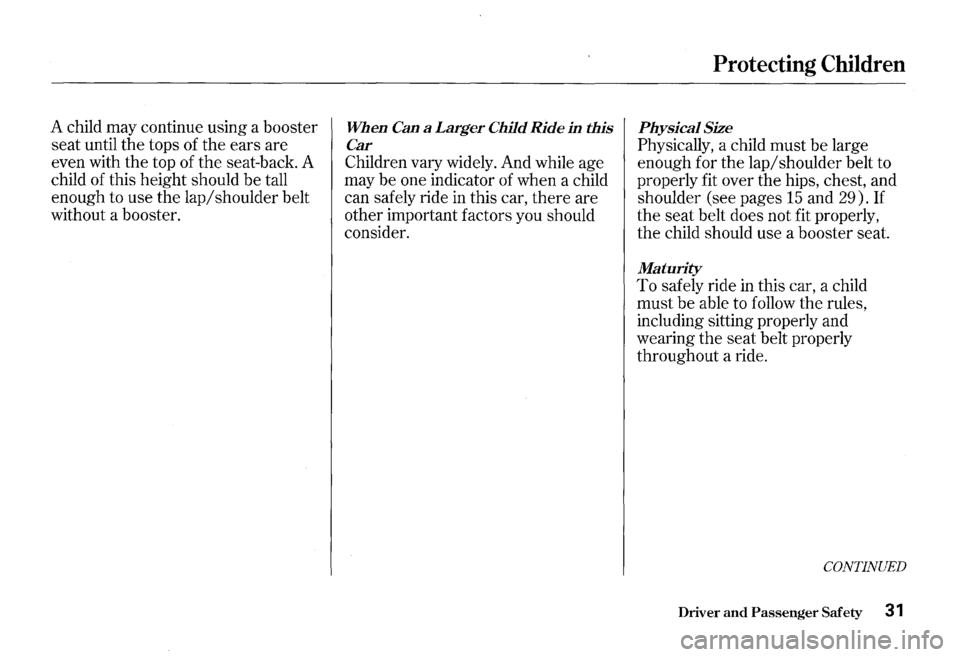
A child may continue using a booster
seat until the tops of the
ears are
even with the top of
the seat-back. A
child of this height should be tall
enough to use the
lap/ shoulder belt
without a booster.
JVhen Can a Larger Child Ride in this
Car
Children vary widely. And while age
may be one indicator of when a child
can safely ride in this car, there are
other important factors you should
consider.
Protecting Children
Physical Size
Physically, a child must be large
enough for the
lap/ shoulder belt to
properly fit over the hips, chest, and
shoulder (see pages
15 and 29). If
the seat belt does not fit properly,
the child should use a booster seat.
Maturity
To safely ride in this car, a child
must be able to follow the rules,
including sitting properly and
wearing
the seat belt properly
throughout a ride.
CONTINUElJ
Driver and Passenger Safety 31
Page 126 of 273
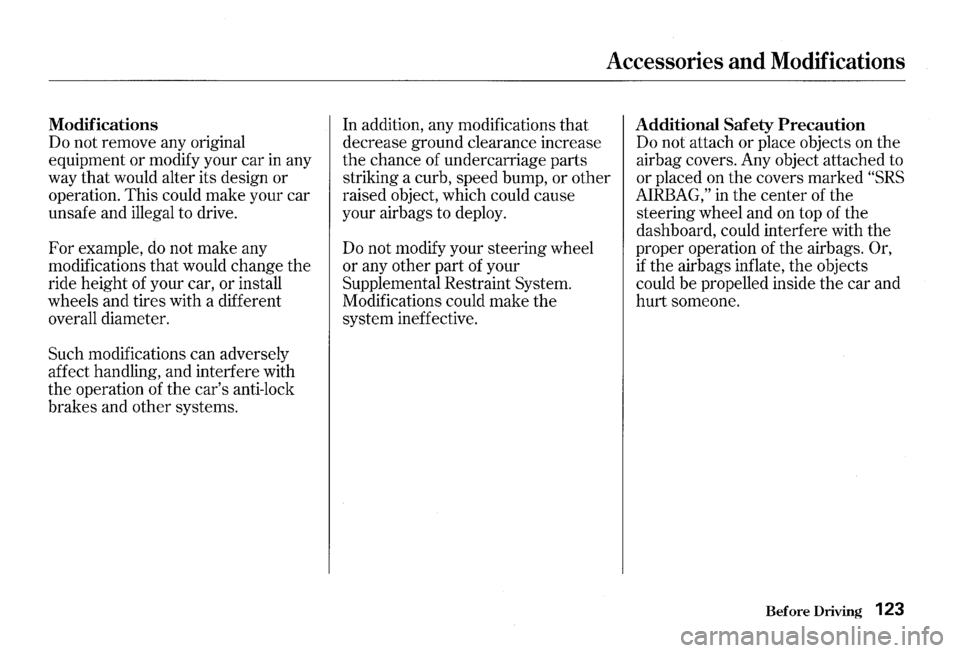
Modifications
Do not remove any original
equipment or modify your car in any
way
that would alter its design or
operation. This could make your car
unsafe and illegal to drive.
For example, do not make any
modifications
that would change the
ride height of your car, or install
wheels and tires with a different
overall diameter.
Such modifications can adversely
affect handling, and interfere with
the operation of the car's anti-lock
brakes and other systems.
Accessories and Modifications
In addition, any modifications that
decrease ground clearance increase
the chance of undercarriage parts
striking a curb, speed bump, or other
raised object, which could cause
your airbags to deploy.
Do not modify your steering wheel
or any other part of your
Supplemental Restraint System.
Modifications could make the
system ineffective. Additional Safety Precaution
Do not attach or place objects on the
airbag covers. Any object attached to
or placed on the covers marked
"SRS
AIRBAG," in the center of the
steering wheel and on top of the
dashboard, could interfere with the
proper operation of the airbags.
Or,
if the airbags inflate, the objects
could be propelled inside the car and
hurt someone.
Before Driving 123
Page 247 of 273

Specifications
Dimensions
Length
Width Height
Wheelbase Track Front
Rear
Engine
Type
Bore x Stroke
Displacement
Compression ratio
Spark plugs
244 Technical Information
162.0in(4,115mm) 68.9 in (1,750 mm)
50.6 in (1,285 mm) 94.5 in (2,400 mm)
57.9 in (1,470 mm)
59.4 in (1,510 mm)
See the certification label attached to the driver's door"amb.
Water cooled 4-stroke DOHC
VTEC 4-cylinder l=)asoline engine
3.43 x 3.31 in (87.0 x 84.0 mm)
121.8 cu-in (1,997 cm3
)
11.0 : 1 See spark plug maintenance
section page
174.
c apac1t1es
Fuel tank 13.2 US
aal (50 ll, 11.0 Imp qal)
Engine coolant
Change*'
1.72 US aal (6.51\, 1.43 Imp qal)
Total 2.01 US l=)al (7.61\, 1.67 Imp gal)
Engine oil Change*'
Including filter 5.1 US qt (4.81\, 4.2 Imp qt)
Without
filter 4.8 USgt (4.51\, 4.0 Imp qt)
Total 5.9 US qt (5.61\, 4.9 Imp qt)
Manual Chanl=)e 1.6 US_g_t (1.51\, 1.31mp qt)
transmission Total 1.7 US qt (1.61\, 1.41mp qt) fluid
Differential Chan_g_e 0.78 US qt (0.741\, 0.65 Imp qt)
oil Total 0.81 US qt (0.77 ll, 0.68 Imp at)
Windshield U.S. Cars 2.7 US qt (2.61\, 2.3 ImP at)
washer Canadian Cars 4.4 US qt (4.21\, 3.7 Imp qt)
reservoir
* 1 : Including the coolant in the reserve tank and that remaining in the
engine. Reserve tank capacity:
0.16 US gal (0.61\, 0.131mp gal)
* 2: Excluding the oil remaining in the engine.
Page 258 of 273
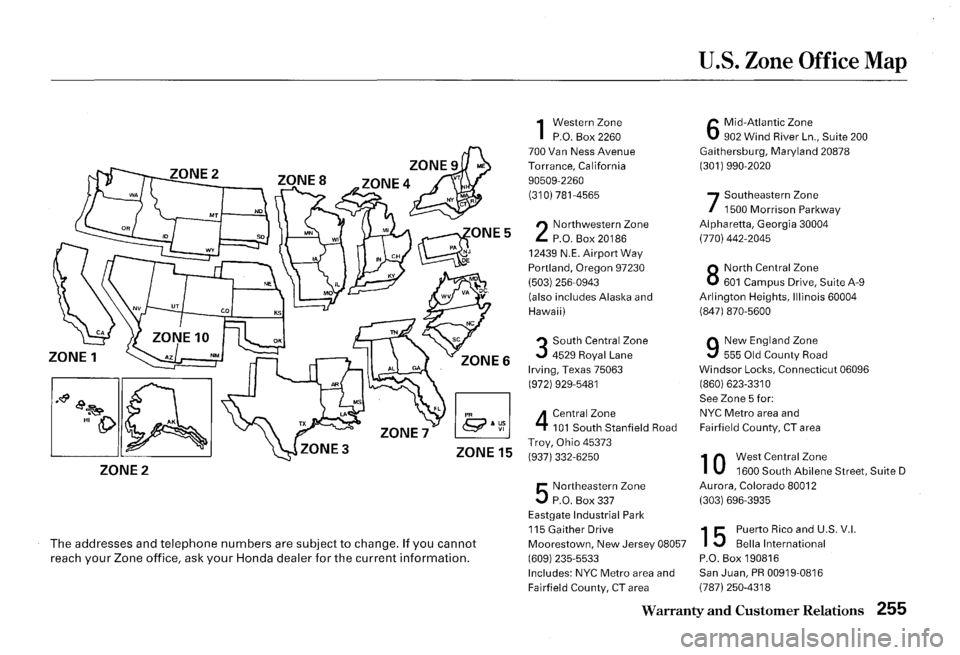
ZONE 15
ZONE2
The addresses and telephone numbers are subject to change. If you cannot reach your Zone office, ask your Honda dealer for the current information.
1 Western Zone P.O. Box 2260
700 Van Ness Avenue
Torrance, California
90509-2260
(310) 781-4565
2 Northwestern Zone P.O. Box 20186 12439 N .E. Airport Way Portland, Oregon 97230 I 503 I 256-0943
(also includes Alaska and
Hawaii)
3 South Central Zone
4529 Royal Lane Irving, Texas 75063 (972) 929-5481
4 Central Zone 101 South Stanfield Road Troy, Ohio 45373
(937) 332-6250
5 Northeastern Zone P.O. Box 337
Eastgate Industrial Park 115 Gaither Drive Moorestown, New Jersey 08057
(609) 235-5533 Includes: NYC Metro area and Fairfield County, CT area
U.S. Zone Office Map
6 Mid-Atlantic Zone 902 Wind River Ln., Suite 200 Gaithersburg, Maryland 20878 (301 I 990-2020
7 Southeastern Zone 1500 Morrison Parkway
Alpharetta, Georgia 30004
(770) 442-2045
8 North Central Zone 601 Campus Drive, Suite A-9 Arlington Heights, Illinois 60004 (847) 870-5600
9 New England Zone
555 Old County Road Windsor Locks, Connecticut 06096
(860) 623-3310
See
Zone 5 for: NYC Metro area and Fairfield County, CT area
1 0 West Central Zone 1600 South Abilene Street, SuiteD Aurora, Colorado 80012
(303) 696-3935
15 Puerto Rico and U.S. V.I.
Bella International
P.O. Box 190816
San Juan, PR 00919-0816 (787) 250-4318
Warranty and Customer Relations 255